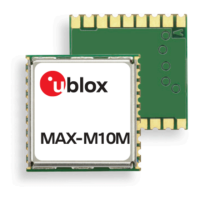MAX-M10M-Integration manual
monitor this information and only power off the receiver when the subsystem is idle (that is,
when the status field shows a steady zero).
•
The UBX-NAV-SAT message indicates the use of AssistNow Autonomous orbits for individual
satellites.
•
The UBX-NAV-ORB message indicates the availability of AssistNow Autonomous orbits for
individual satellites.
•
The UBX-MGA-DBD message provides a means to retrieve the AssistNow Autonomous data
from the receiver in order to preserve the data in power-off mode where no battery backup is
available. Note that the receiver requires the absolute time (i.e. full date and time) to calculate
AssistNow Autonomous orbits. For the best performance, it is therefore recommended to supply
this information to the receiver using the UBX-MGA-INI-TIME_UTC message in this scenario.
3.12.4.3 Benefits and drawbacks
AssistNow Autonomous can provide quicker startup times by lowering the TTFF, provided that data
is available for enough visible satellites. This is particularly true under weak signal conditions where
it might not be possible to download broadcast ephemerides at all and therefore, no fix would be
possible without AssistNow Autonomous (or A-GNSS). It is however required that the receiver roughly
knows the absolute time, either from an RTC or from time-aiding (see the Interface section), and
that it knows which satellites are visible, either from the almanac or from tracking the respective
signals.
The AssistNow Autonomous orbit (satellite position) accuracy depends on various factors, such as
the particular type of satellite, the accuracy of the underlying broadcast ephemeris, or the orbital
phase of the satellite and Earth, and the age of the data (errors add up over time).
AssistNow Autonomous will typically extend a broadcast ephemeris from three up to six days. The
CFG-ANA-ORBMAXERR item allows changing this threshold by setting the «maximum acceptable
modeled orbit error» (in meters). Note that this number does not reflect the true orbit error
introduced by extending the ephemeris. It is a statistical value that represents a certain expected
upper limit based on a number of parameters. A rough approximation that relates the maximum
extension time to this setting is: maxError [m] = maxAge [d] * f, where the factor f is 30 for data
derived from satellites seen once and 16 for data derived for satellites seen multiple times during a
long enough time period (see the Concept section).
There is no direct relation between (true and statistical) orbit accuracy and positioning accuracy. The
positioning accuracy depends on various factors, such as the satellite position accuracy, the number
of visible satellites, and the geometry (DOP) of the visible satellites. Position fixes that include
AssistNow Autonomous orbit information may be significantly worse than fixes using only broadcast
ephemerides. Therefore, it might be necessary to adjust the limits of the navigation output filters
(CFG-NAVSPG-OUTFIL_XXXX).
Unknown future events form a fundamental deficiency of any system and can prevent precise
satellite orbit predictions. Hence, the receiver will not be able to know about satellites that will
have become unhealthy, have undergone a clock swap, or have had a maneuver. This means that
the navigation engine might rarely mistake a wrong satellite position as the true satellite position.
However, provided that there are enough other good satellites, the navigation algorithms will
eventually eliminate a defective orbit from the navigation solution.
The repeatability of the satellite constellation is a potential pitfall for the use of the AssistNow
Autonomous feature. For a given location on Earth, the (GPS) constellation (geometry of visible
satellites) repeats every 24 hours. Hence, when the receiver «learned» about a number of satellites
at some point in time, the same satellites will in most places not be visible 12 hours later, and the
UBX-22038241 - R02
3 Receiver functionality Page 60 of 92
C1-Public

